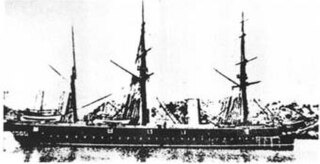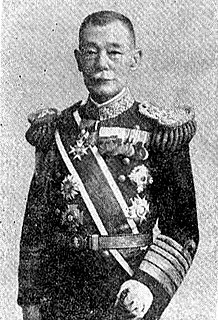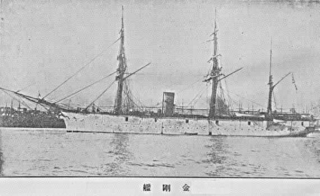
Okada Keisuke was an admiral in the Imperial Japanese Navy, politician and Prime Minister of Japan from 1934 to 1936.

Baron Kantarō Suzuki was an admiral in the Imperial Japanese Navy, member and final leader of the Imperial Rule Assistance Association and Prime Minister of Japan from 7 April to 17 August 1945.

The Imperial Japanese Navy was the navy of the Empire of Japan from 1868 until 1945, when it was dissolved following Japan's surrender in World War II. The Japan Maritime Self-Defense Force (JMSDF) was formed circa 1952–1954 after the dissolution of the IJN.

Hiei (比叡) was a warship of the Imperial Japanese Navy during World War I and World War II. Designed by British naval architect George Thurston, she was the second launched of four Kongō-class battlecruisers, among the most heavily armed ships in any navy when built. Laid down in 1911 at the Yokosuka Naval Arsenal, Hiei was formally commissioned in 1914. She patrolled off the Chinese coast on several occasions during World War I, and helped with rescue efforts following the 1923 Great Kantō earthquake.

Kongō was a warship of the Imperial Japanese Navy during World War I and World War II. She was the first battlecruiser of the Kongō class, among the most heavily armed ships in any navy when built. Her designer was the British naval engineer George Thurston, and she was laid down in 1911 at Barrow-in-Furness in Britain by Vickers Shipbuilding Company. Kongō was the last Japanese capital ship constructed outside Japan. She was formally commissioned in 1913, and patrolled off the Chinese coast during World War I.

Kirishima (霧島) was a warship of the Imperial Japanese Navy during World War I and World War II. Designed by British naval engineer George Thurston, she was the third launched of the four Kongō-class battlecruisers. Laid down in 1912 at the Mitsubishi Shipyards in Nagasaki, Kirishima was formally commissioned in 1915 on the same day as her sister ship, Haruna. Kirishima patrolled on occasion off the Chinese coast during World War I, and helped with rescue efforts following the 1923 Great Kantō earthquake.

Kongō was the lead ship of the Kongō-class ironclad corvettes built for the Imperial Japanese Navy (IJN) in the 1870s. The class was built in the United Kingdom because such ships could not yet be constructed in Japan. Completed in 1878, Kongō briefly served with the Small Standing Fleet before becoming a training ship in 1887, thereafter making training cruises to the Mediterranean and to countries on the edge of the Pacific Ocean. The ship returned to active duty during the First Sino-Japanese War of 1894–95 where she participated in the Battle of Weihaiwei. Kongō resumed her training duties after the war, though she also played a minor role in the Russo-Japanese War of 1904–05. The ship was reclassified as a survey ship in 1906 and was sold for scrap in 1910.

Hiei was the second and last vessel of the Kongō-class ironclad corvettes built for the Imperial Japanese Navy (IJN) in the 1870s. They were built in the United Kingdom because the Japanese were unable to build ironclad warships in Japan. She became a training ship in 1887 and made training cruises to the Mediterranean and to countries on the edge of the Pacific Ocean. The ship returned to active duty during the First Sino-Japanese War of 1894–1895 where she was damaged during the Battle of the Yalu River. Hiei also participated in the Battle of Weihaiwei and the invasion of Formosa in 1895. The ship resumed her training duties after the war, although she played a minor role in the Russo-Japanese War of 1904–1905. She was reclassified as a survey ship in 1906 and was sold for scrap in 1912.

Fusō was a central-battery ironclad built for the Imperial Japanese Navy (IJN) in the 1870s. She was built in the United Kingdom because such ships could not yet be constructed in Japan. The ship participated in the First Sino-Japanese War of 1894–95 where she was damaged during the Battle of the Yalu River in 1894 and participated in the Battle of Weihaiwei in early 1895. She collided with two Japanese ships during a storm and sank in 1897. She was refloated the following year and repaired. Fusō played a minor role in the Russo-Japanese War of 1904–1905 and was reclassified as a coast defense ship after the war. She was struck from the Navy List in 1908 and sold for scrap the following year.

Mount Kongō is a 1,125-metre-high (3,691 ft) mountain in the Kawachi region of Osaka Prefecture, Kansai, Japan. It is near Mount Yamato Katsuragi.

BaronYamashita Gentarō was an admiral in the early Imperial Japanese Navy.

The Kongō-class battlecruiser was a class of four battlecruisers built for the Imperial Japanese Navy (IJN) immediately before World War I. Designed by British naval architect George Thurston, the lead ship of the class, Kongō, was the last Japanese capital ship constructed outside Japan, by Vickers at Barrow-in-Furness. Her sister ships, Haruna, Kirishima and Hiei, were all completed in Japan.

Kurama (鞍馬) was the final vessel of the two-ship Ibuki class of armored cruisers in the Imperial Japanese Navy. Kurama was named after Mount Kurama located north of Kyoto, Japan. On 28 August 1912, the Ibukis were re-classified as battlecruisers.
Kongo class may refer to either:

The Vickers 14 inch 45 calibre gun was designed and built by Vickers and initially installed on the battlecruiser Kongō which it was building for the Imperial Japanese Navy. Guns similar to this Vickers design were also later built in Japan to arm Kongō's sister ships and subsequent Japanese-constructed "super-dreadnoughts" which were all built in Japan. Japanese-built versions of the guns were designated 14 inch 41st Year Type, and from 1917 when the Navy went metric they were redesignated 36 cm 41st Year Type.

The Kongō-class ironclads (金剛型) were a pair of armored corvettes built for the Imperial Japanese Navy (IJN) by British shipyards in the 1870s. A British offer to purchase the two ships during the Russo-Turkish War in 1878 was refused. They became training ships in 1887 and made training cruises to the Mediterranean and to countries on the edge of the Pacific Ocean. The ships returned to active duty during the First Sino-Japanese War of 1894–95 where one participated in the Battle of the Yalu River and both in the Battle of Weihaiwei. The Kongō-class ships resumed their training duties after the war, although they played a minor role in the Russo-Japanese War of 1904–05. They were reclassified as survey ships in 1906 and were sold for scrap in 1910 and 1912.

The Dingyuan class consisted of a pair of ironclad warships—Dingyuan and Zhenyuan—built for the Imperial Chinese Navy in the 1880s. They were the first ships of that size to be built for the Chinese Navy, having been constructed by Stettiner Vulcan AG in Germany. Originally expected to be a class of 12 ships, before being reduced to three and then two, with Jiyuan was reduced in size to that of a protected cruiser.
Three naval vessels of Japan have been named Fusō:
Three naval vessels of Japan have been named Kongō:
This page is based on this
Wikipedia article Text is available under the
CC BY-SA 4.0 license; additional terms may apply.
Images, videos and audio are available under their respective licenses.















